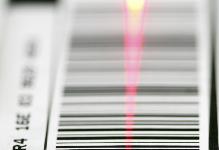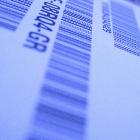 | |||||
 | |||||
| ||
 | |||||
 | |||||
New GS1 bar code symbologies
In the last few years some new bar code symbologies, or types, have been introduced into the GS1 system. These were initially introduced to encourage the healthcare industry to standardize on GS1 standards, however, some of these bar codes are now also about to become important in the retail industry.
A family of linear bar codes, which was originally named RSS (Reduced Space Symbology) was invented for use by GS1 almost ten years ago now. There were two specific aims when these codes were invented, the first being to make it possible to encode standard GS1 item numbers in a smaller space than was possible with existing GS1 bar code types, and in addition these new bar codes should be readable in any orientation just as with the EAN and UPC bar codes which are currently used on products in retail stores. This ability to read these bar codes in any orientation makes scanning efficiency very high when they are scanned with the typical point-of-sale omnidirectional scanners.
The RSS bar code family was recently renamed GS1 DataBar and many scanning and printing products and software still refer to the original RSS name. These bar codes have been used on packaging for drugs for a number of years now in North America where their small size has enabled blister packs of individual pills to be marked so that when dispensing drugs in hospitals it has been possible for nursing staff to scan single pills as they are given to patients.
GS1 have announced that from January 1st 2010 the GS1 DataBar bar codes can be used in the retail industry both at point-of-sale and also in the supply chain. The main initial benefits are expected at the point-of-sale on items that have previously been difficult to label with existing bar code symbols because of the small size of the products. Individual apples will usually carry small labels that include a 4 digit number to identify them and checkout systems have been developed that allow the staff to key enter this number in order to identify the apple. Some retailers are now trialling using labels that carry a stacked version of GS1 DataBar so that the individual apples (or other similar fruit) can actually be scanned.
There are other small product types that may also benefit from using GS1 DataBar, however, one of the more interesting uses of a particular bar code type in the GS1 DataBar family called GS1 DataBar Expanded, is that this bar code can carry more than just the item number. Other attributes such as best before dates, weight, batch and serial numbers can also be encoded in the same bar code and this opens up new potential opportunities for the systems that retailers use in conjunction with this information.
Another use of GS1 DataBar Expanded that is being introduced in North America only at present, is to use the larger data carrying capacity of this bar code type to identify coupon offers. Until the beginning of this year the bar codes used on coupons could only carry very limited data, or if additional data was required then multiple bar codes were required. Now the GS1 DataBar Expanded bar code can encode information about the coupon offer, the value of the coupon and any dependency there is on having to purchase other products in conjunction with the offer. This new system is being gradually introduced over the next couple of years and by January 2010 the existing UPC based coupon bar codes will be phased out in North America.
There is much interest in the use of two-dimensional, 2D, bar code symbols in various industries but particularly the healthcare industries in Europe because these bar codes allow large amounts of data to be encoded in reasonably small spaces. GS1 have adopted one of the Matrix bar code symbols in order to meet these needs and its name is GS1 Data Matrix. The 2D matrix bar codes cannot be scanned with conventional laser scanning technology, so they are not likely to appear on retail items, however, the camera style imaging scanners which these bar codes do require are becoming more and more popular and so pharmacies, hospitals and other healthcare environments are keen to adopt this bar code and the format of data that the GS1 standard states.